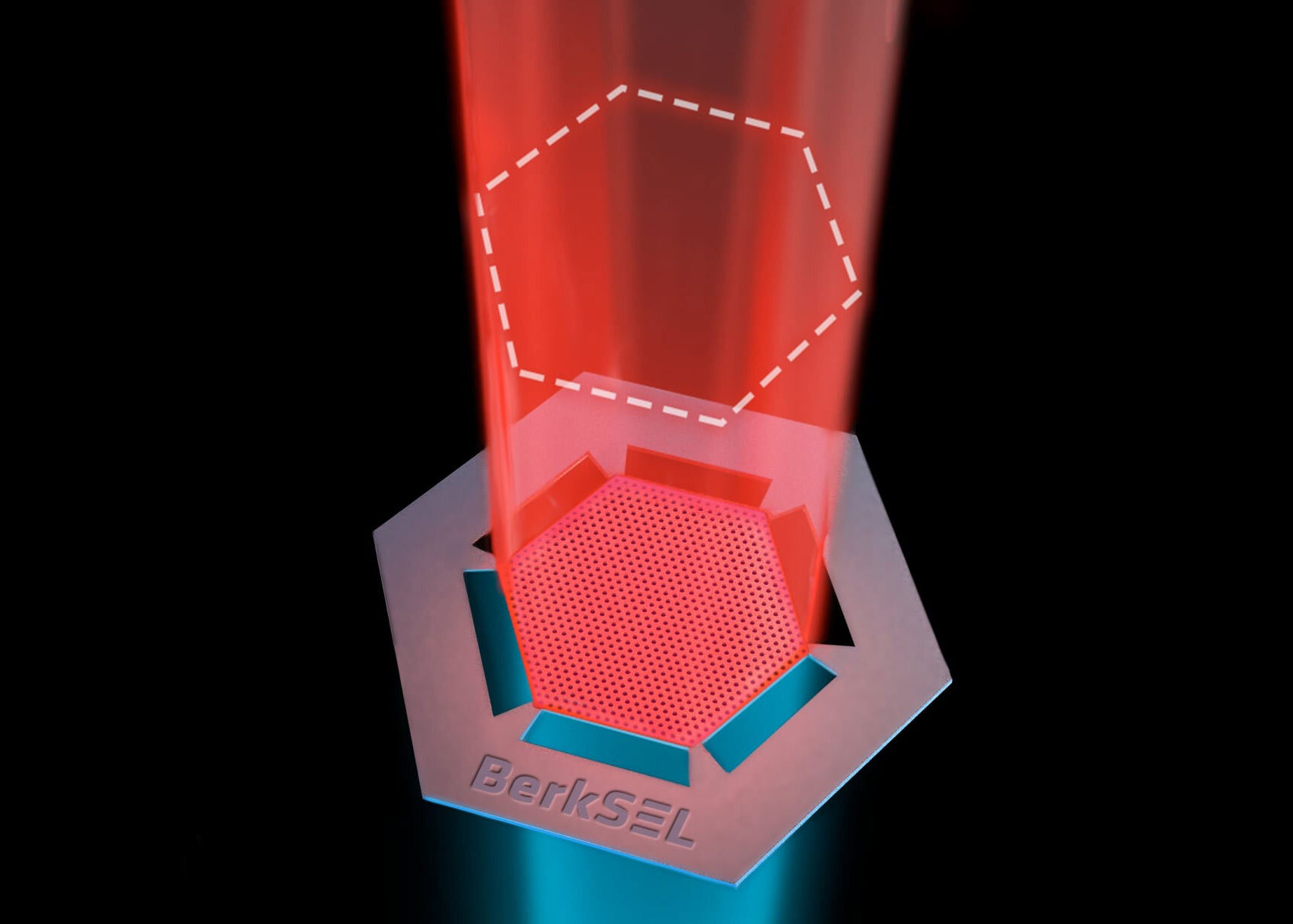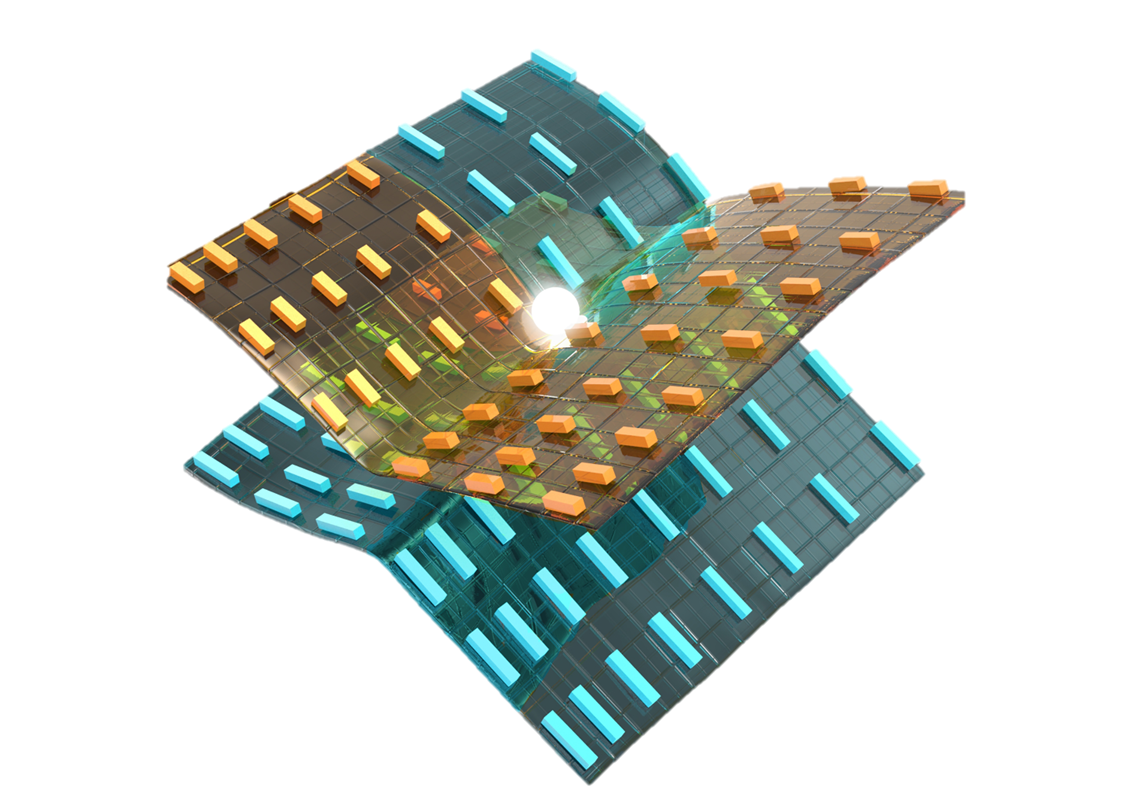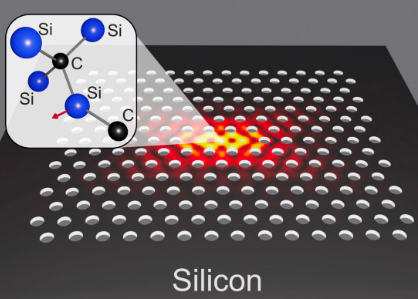About Us
We are dedicated to multidisciplinary research in the area of wave-matter interaction from microwaves to optics. Grounded on the fundamental physical principles, and the on-demand dimensionality of materials and nanomaterials, we address tantalizing experimental and theoretical physical questions in the fields of nanophotonics, plasmonics, and metamaterials applicable to global energy, defense, and health challenges.
Featured















Color centers in silicon for scalable quantum networks
Redjem and colleagues’ work started the investigation of colour centres in silicon wafers worldwide. In the five years since their original experiment, researchers have integrated single defects into waveguides and shown the indistinguishability of photons emitted from a single G-center. Colour centres in silicon can now be deterministically created using focused ion beams and femtosecond laser pulses. Some defects in silicon can not only create single photons but also serve as spin–photon interfaces, connecting spin states with optical transitions, which enables colour centres to store and transfer quantum information.
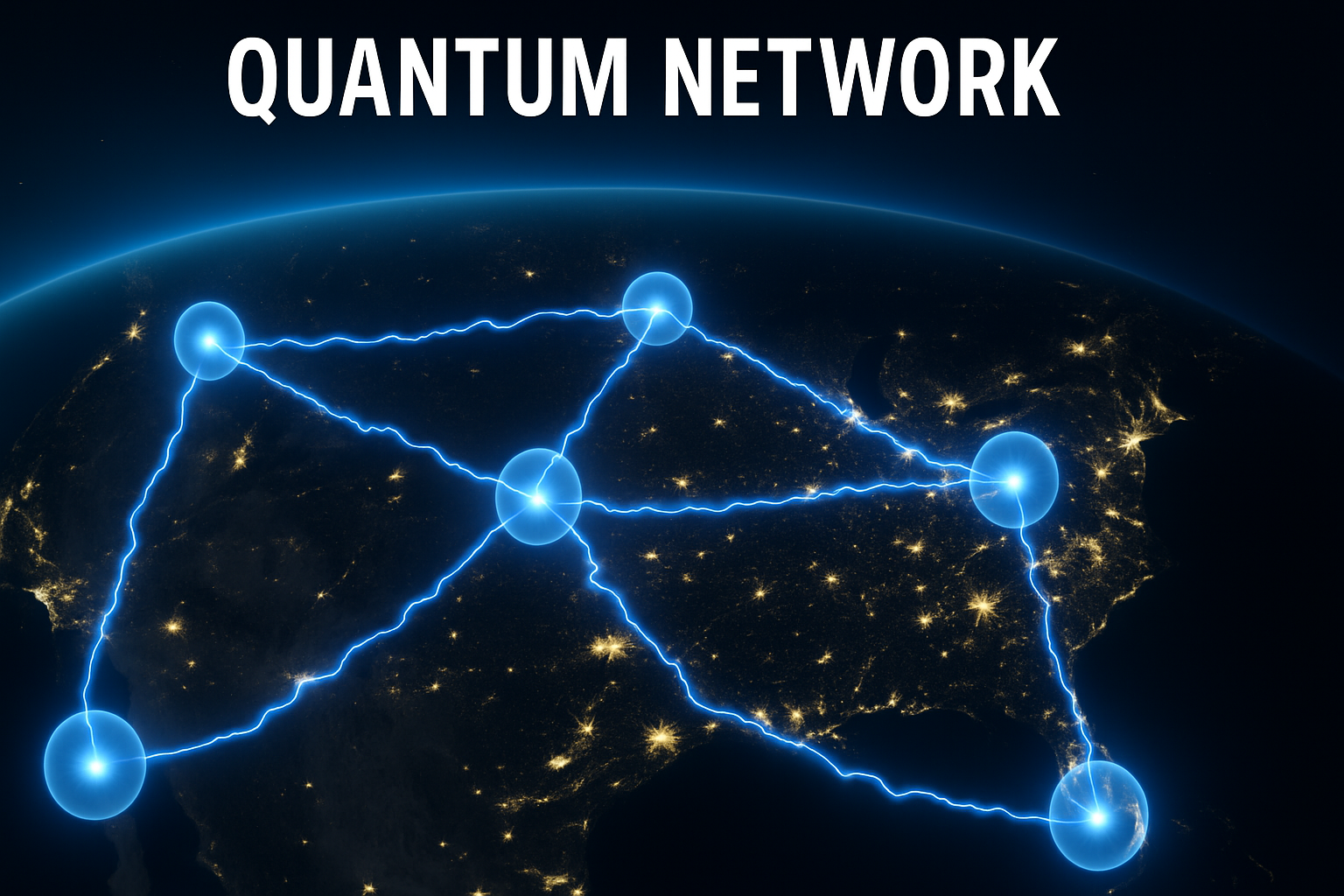
BerkSEL: A scale-invariant laser beyond the Schawlow-Townes two-mirror strategy
Our new insight and approach address a challenge spanning over six decades, surpassing the conventional Schawlow-Townes style optical cavity. The resulting solution introduces a novel scale-invariant lasing mode, unpredicted and unobserved in any wave physics system to date.
Programmable quantum emitter formation in silicon

Silicon-based quantum emitters are candidates for large-scale qubit integration due to their single-photon emission properties and potential for spin-photon interfaces with long spin coherence times. Here, we demonstrate local writing and erasing of selected light-emitting defects using femtosecond laser pulses in combination with hydrogen-based defect activation and passivation at a single center level. Fs-laser pulses locally affect the passivation or activation of quantum emitters with hydrogen for programmable formation of selected quantum emitters.
Interpretable inverse-designed cavity for on-chip nonlinear photon pair generation
Inverse design is a powerful tool in wave physics for compact, high-performance devices. To date, applications in photonics have mostly been limited to linear systems and it has rarely been investigated or demonstrated in the nonlinear regime. In addition, the “black box” nature of inverse design techniques has hindered the understanding of optimized inverse-designed structures. We propose an inverse design method with interpretable results to enhance the efficiency of on-chip photon generation rate through nonlinear processes by controlling the effective phase-matching conditions. We fabricate and characterize a compact, inverse-designed device using a silicon-on-insulator platform that allows a spontaneous four-wave mixing process to generate photon pairs at a rate of 1.1 MHz with a coincidence to accidental ratio of 162. Our design method accounts for fabrication constraints and can be used for scalable quantum light sources in large-scale communication and computing applications.

All-silicon quantum light source by embedding an atomic emissive center in a nanophotonic cavity
Silicon is the most scalable optoelectronic material but has suffered from its inability to generate directly and efficiently classical or quantum light on-chip. Scaling and integration are the most fundamental challenges facing quantum science and technology. We report an all-silicon quantum light source based on a single atomic emissive center embedded in a silicon-based nanophotonic cavity. We observe a more than 30-fold enhancement of luminescence, a near-unity atom-cavity coupling efficiency, and an 8-fold acceleration of the emission from the all-silicon quantum emissive center. Our work opens immediate avenues for large-scale integrated cavity quantum electrodynamics and quantum light-matter interfaces with applications in quantum communication and networking, sensing, imaging, and computing.
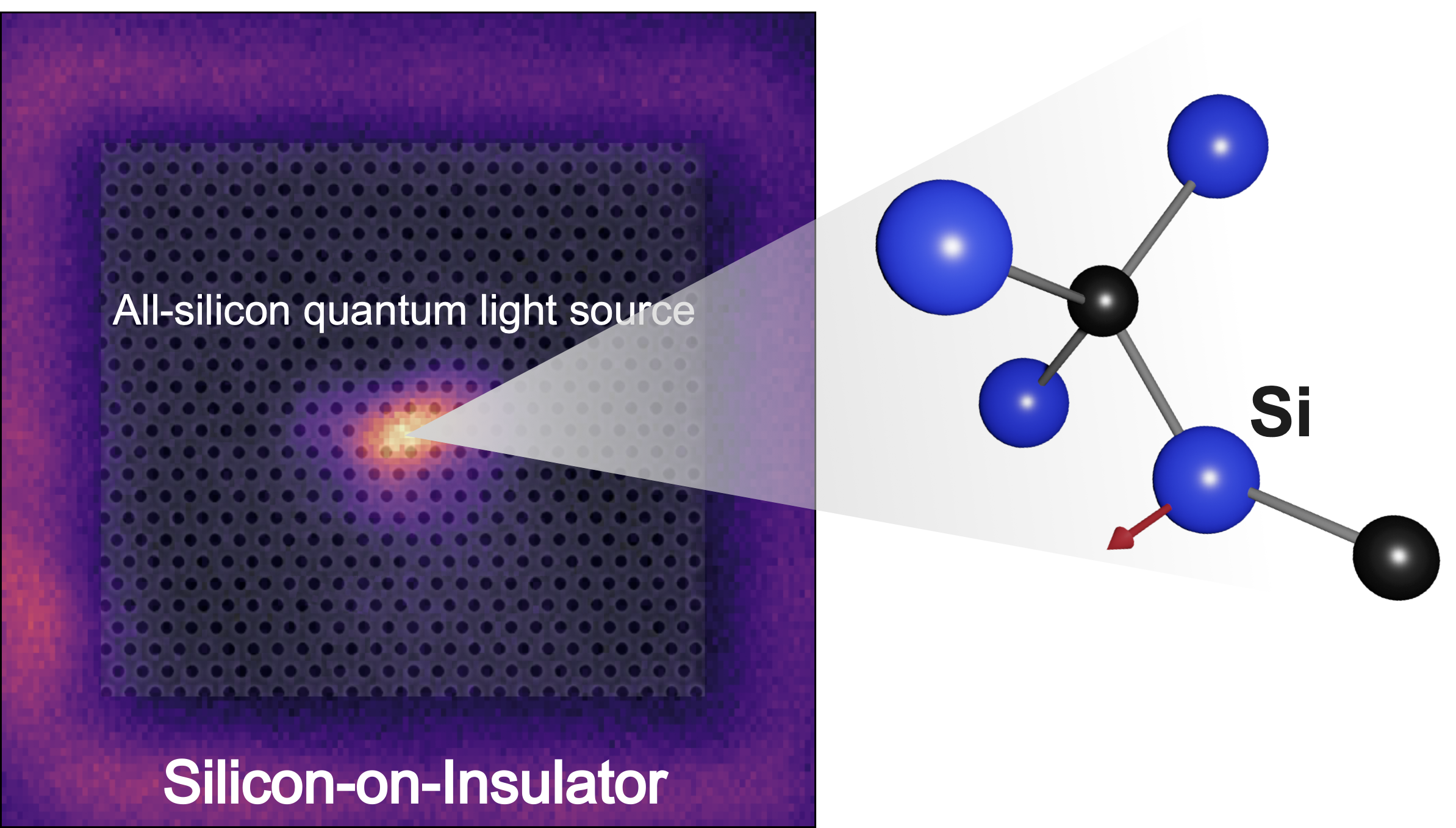
Disordered topological graphs enhancing nonlinear phenomena
Complex networks play a fundamental role in understanding phenomena from the collective behavior of spins, neural networks, and power grids to the spread of diseases. Topological phenomena in such networks have recently been exploited to preserve the response of systems in the presence of disorder. We propose and demonstrate topological structurally disordered systems with a modal structure that enhances nonlinear phenomena in the topological channels by inhibiting the ultrafast leakage of energy from edge modes to bulk modes. We present the construction of the graph and show that its dynamics enhances the topologically protected photon pair generation rate by an order of magnitude. Disordered nonlinear topological graphs will enable advanced quantum interconnects, efficient nonlinear sources, and light-based information processing for artificial intelligence.

Scalable single-mode surface emitting laser via open-Dirac singularities
Single-aperture cavities are a key component of lasers, instrumental for the amplification and emission of a single light mode. However, the appearance of high-order transverse modes as cavities size increases has frustrated efforts to scale up cavities whilst preserving single-mode operation since the invention of the laser six decades ago. A suitable physical mechanism that allows single-mode lasing irrespective of the cavity size – a “scale-invariant” cavity or laser – has not been identified yet. Here, we propose and demonstrate experimentally that open-Dirac electromagnetic cavities with linear dispersion – which in our devices are realized by a truncated photonic crystal arranged in a hexagonal pattern – exhibit unconventional scaling of losses in reciprocal space, leading to single-mode lasing that is maintained as the cavity is scaled up in size. We name such sources Berkeley Surface Emitting Lasers (BerkSELs) and demonstrate that their far-field corresponds to a topological singularity of charge two, in agreement with our theory. Open-Dirac cavities unlock new avenues for light-matter interaction and cavity quantum electrodynamics.

Exploration of Defect Dynamics and Color Center Qubit Synthesis with Pulsed Ion Beams
Short-pulse ion beams have been developed in recent years and now enable applications in materials science. A tunable flux of selected ions delivered in pulses of a few nanoseconds can affect the balance of defect formation and dynamic annealing in materials. We report results from color center formation in silicon with pulses of 900 keV protons. G-centers in silicon are near-infrared photon emitters with emerging applications as single-photon sources and for spin-photon qubit integration. G-centers consist of a pair of substitutional carbon atoms and one silicon interstitial atom and are often formed by carbon ion implantation and thermal annealing. Here, we report on G-center formation with proton pulses in silicon samples that already contained carbon, without carbon ion implantation or thermal annealing. We observe a G-center ensemble linewidth of 0.1 nm (full width half maximum), narrower than previously reported. Pulsed ion beams can extend the parameter range available for fundamental studies of radiation-induced defects and the formation of color centers for spin-photon qubit applications.

Plasmonic topological metasurface by encircling an exceptional point
Resonant scattering, guided mode propagation phase, and/or orientation-dependent phase retardations are the three main mechanisms used to date to conceive optical metasurfaces. Here, we introduce an additional degree of freedom to address optical phase engineering by exploiting the topological features of non-Hermitian matrices operating near their singular points. Choosing metasurface building blocks to encircle a singularity following an arbitrarily closed trajectory in parameter space, we engineered a topologically protected full 2π-phase on a specific reflected polarization channel. The ease of implementation together with its compatibility with other phase-addressing mechanisms bring topological properties into the realm of industrial applications at optical frequencies and prove that metasurface technology represents a convenient test bench to study and validate topological photonic concepts.

Photonic quantum Hall effect and multiplexed light sources of large orbital angular momenta
The quantum Hall effect involves electrons confined to a two-dimensional plane subject to a perpendicular magnetic field, but it also has a photonic analogue. Using heterostructures based on structured semiconductors on a magnetic substrate, we introduce compact and integrated coherent light sources of large orbital angular momenta based on the photonic quantum Hall effect. The photonic quantum Hall effect enables the direct and integrated generation of coherent orbital angular momenta beams of large quantum numbers from light travelling in leaky circular orbits at the interface between two topologically dissimilar photonic structures. Our work gives direct access to the infinite number of orbital angular momenta basis elements and will thus enable multiplexed quantum light sources for communication and imaging applications.

Experimental demonstration of single-mode topological valley-Hall lasing at telecommunication wavelength.
Topology plays a fundamental role in contemporary physics and enables new information processing schemes and wave device physics with built-in robustness. However, the creation of photonic topological phases usually requires complex geometries that limit the prospect for miniaturization and integration and dispossess designers of additional degrees of freedom needed to control topological modes on-chip. By controlling the degree of asymmetry (DoA) in a photonic crystal with broken inversion symmetry, we report single-mode lasing of valley-Hall ring cavities at telecommunication wavelength. Our results open the door to novel optoelectronic devices and systems based on compact topological integrated circuits.

Octave bandwidth photonic fishnet-achromatic-metalens
Planar structured interfaces, also known as metasurfaces, are continuously attracting interest owing to their ability to manipulate fundamental attributes of light, including angular momentum, phase, or polarization. However, chromatic aberration, limiting broadband operation, has remained a challenge for metasurfaces-based optical components and imagers. Here we report and experimentally demonstrate polarization-independent fishnet-achromatic-metalenses with measured average efficiencies over 70% in the continuous band from the visible (640 nm) to the infrared (1200 nm). Results of the scalable platform are enabling for applications requiring broad bandwidth and high efficiency including energy harvesting, virtual reality and information processing devices, or medical imaging.


Symmetry-breaking-induced plasmonic exceptional points and nanoscale sensing
Singularities of open systems, known as exceptional points (EPs), have been shown to exhibit increased sensitivities, but the observation of EPs has so far been limited to wavelength-scaled systems subject to the diffraction limit. We propose a novel approach to EPs based on spatial symmetry breaking and report their observation in plasmonics at room temperature. Their utility as sensors of anti-immunoglobulin G, the most abundant immunoglobulin isotype in human serum, is evaluated. Our work opens the way to a new class of nanoscale devices, sensors and imagers based on topological polaritonic effects.

Nonreciprocal lasing in topological cavities of arbitrary geometries
Resonant cavities that confine light are crucial components of lasers. Typically, these cavities are designed to high specification to get the best possible output. That, however, can limit their integration into photonic devices and optical circuits. The confinement of light to topologically protected edge states can result in unidirectional propagation and confinement over arbitrary geometries. Relaxing the resonant cavity design criteria should be useful in designing photonic devices.


Lasing action from photonic bound states in continuum
In 1929, only three years after the advent of quantum mechanics, von Neumann and Wigner showed that Schrödinger’s equation can have bound states above the continuum threshold. These peculiar states, called bound states in the continuum (BICs), manifest themselves as resonances that do not decay. Here we report, at room temperature, lasing action from an optically pumped BIC cavity. BIC lasers open up new avenues in the study of light–matter interaction because they are intrinsically connected to topological charges and represent natural vector beam sources which are highly sought after in the fields of optical trapping, biological sensing and quantum information.

Research
Recent Publications
- Z. Jia, H.Rubio, L. Neim, J. Park, S. Preble, and B.Kanté, “Multi-dimensional optical computing,” Opt. Lett. 50, 5498-5501 (2025)
- E. Dresselhaus, A. Avdoshkin, Z. Jia, M. Seclí, B. Kanté, and J. Moore, “A tale of two localizations: Coexistence of flat bands and Anderson localization in a photonics-inspired amorphous system“, Phys. Rev. B 112, 064202
- Y. Zhiyenbayev, “Colour centres in silicon for scalable quantum networks,” Nat Rev Phys 7, 284 (2025).
- K. Behrouzi, Z. Wu, L. Lin, and B. Kante, “Single plasmonic exceptional point nanoantenna coupled to a photonic integrated circuit sensor,” Photon. Res. 13, 632-641 (2025).
- Z. Jia, H. Rubio, L. Neim, J. Park, S. Preble, and B. Kanté, “Multi-dimensional optical neural network,” arXiv preprint arXiv:2411.16140v1 (2024).
- K. Jhuria, V. Ivanov, D. Polley, Y. Zhiyenbayev, W. Liu, A. Persaud, W. Redjem, W. Qarony, P. Parajuli, Q. Ji, A. J. Gonsalves, J. Bokor, L. Z. Tan, B. Kanté and T. Schenkel, “Programmable quantum emitter formation in silicon,” Nat Commun 15, 4497 (2024).
- E. J. Dresselhaus, A. Avdoshkin, Z. Jia, M. Secli, B. Kante, J. E. Moore, “A tale of two localizations: coexistence of flat bands and Anderson localization in a photonics-inspired amorphous system,” arXiv preprint arXiv:2404.17578 (2024).
- B. Kanté, “BerkSEL: A scale-invariant laser beyond the Schawlow-Townes two-mirror strategy,” Nat Commun 15, 2047 (2024).
- Z. Yang, PS. Huang, YT. Lin et al., “Creating pairs of exceptional points for arbitrary polarization control: asymmetric vectorial wavefront modulation,” Nat Commun 15, 232 (2024).
- Z. Jia, W. Qarony, J. Park, S. Hooten, D. Wen, Y. Zhiyenbayev, M. Seclì, W. Redjem, S. Dhuey, A. Schwartzberg, E. Yablonovitch, and B. Kanté, “Interpretable inverse-designed cavity for on-chip nonlinear photon pair generation,” Optica 10, 1529-1534 (2023).
- W. Liu, V. Ivanov, K. Jhuria, Q. Ji, A. Persaud, W. Redjem, J. Simoni, Y. Zhiyenbayev, B. Kante, J. G. Lopez, L. Z. Tan, and T. Schenkel, “Quantum Emitter Formation Dynamics and Probing of Radiation-Induced Atomic Disorder in Silicon,” Phys. Rev. Applied 20, 014058 (2023).
- K. Jhuria, V. Ivanov, D. Polley, W. Liu, A. Persaud, Y. Zhiyenbayev, W. Redjem, W. Qarony, P. Parajuli, Qing Ji, A. J. Gonsalves, J. Bokor, L. Z. Tan, B. Kante, and T. Schenkel, “Programmable quantum emitter formation in silicon,” arXiv preprint arXiv:2307.05759 (2023).
- W. Redjem*, Y. Zhiyenbayev*, W. Qarony* et al., “All-silicon quantum light source by embedding an atomic emissive center in a nanophotonic cavity,” Nat Commun 14, 3321 (2023).
- Z. Jia, M. Seclì, A. Avdoshkin et al., “Disordered topological graphs enhancing nonlinear phenomena,” Sci. Adv. 9, 14 (2023).
- V. Ivanov, A. Ivanov, J. Simoni, P. Parajuli, B. Kanté, T. Schenkel, and L. Z. Tan, “Database of semiconductor point-defect properties for applications in quantum technologies,” arXiv preprint arXiv.2303.16283 (2023).
- W. Redjem, A.J. Amsellem, F.I. Allen et al., “Defect engineering of silicon with ion pulses from laser acceleration,” Commun Mater 4, 22 (2023).
- Y. Zhiyenbayev, W. Redjem, V. Ivanov, W. Qarony, C. Papapanos, J. Simoni, W. Liu, K. Jhuria, L. Z. Tan, T. Schenkel, and B. Kanté, “Scalable manufacturing of quantum light emitters in silicon under rapid thermal annealing,” Opt. Express 31, 8352-8362 (2023).
- R. Contractor*, W. Noh*, W. Redjem* et al., “Scalable single-mode surface emitting laser via open-Dirac singularities,” Nature 608, 692–698 (2022).
- R. Pestourie, W. Yao, B. Kanté, and S. G. Johnson, “Efficient Inverse Design of Large-Area Metasurfaces for Incoherent Light,” ACS Photonics (2022).
- H. Qin, W. Redjem, and B. Kanté, “Tunable and enhanced optical force with bound state in the continuum,” Opt. Lett. 47 (7), 1774-1777 (2022).
- V. Ivanov, J. Simoni, Y. Lee, W. Liu, K. Jhuria, W. Redjem, Y. Zhiyenbayev, C. Papapanos, W. Qarony, B. Kanté, A. Persaud, T. Schenkel, and L. Z. Tan, “Effect of localization on photoluminescence and zero-field splitting of silicon color centers,” Phys. Rev. B 106, 134107 (2022).
- T. Schenkel, W. Redjem, A. Persaud, W. Liu, PA Seidl, AJ Amsellem, B. Kanté, and Q. Ji, “Exploration of Defect Dynamics and Color Center Qubit Synthesis with Pulsed Ion Beams,” Quantum Beam Sci., 6 (1), 13 (2022).
